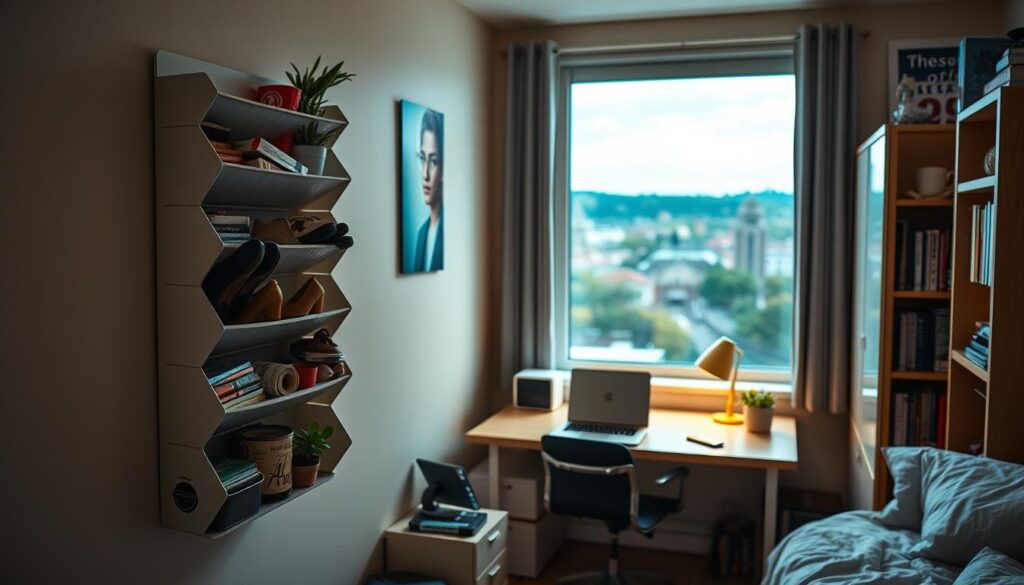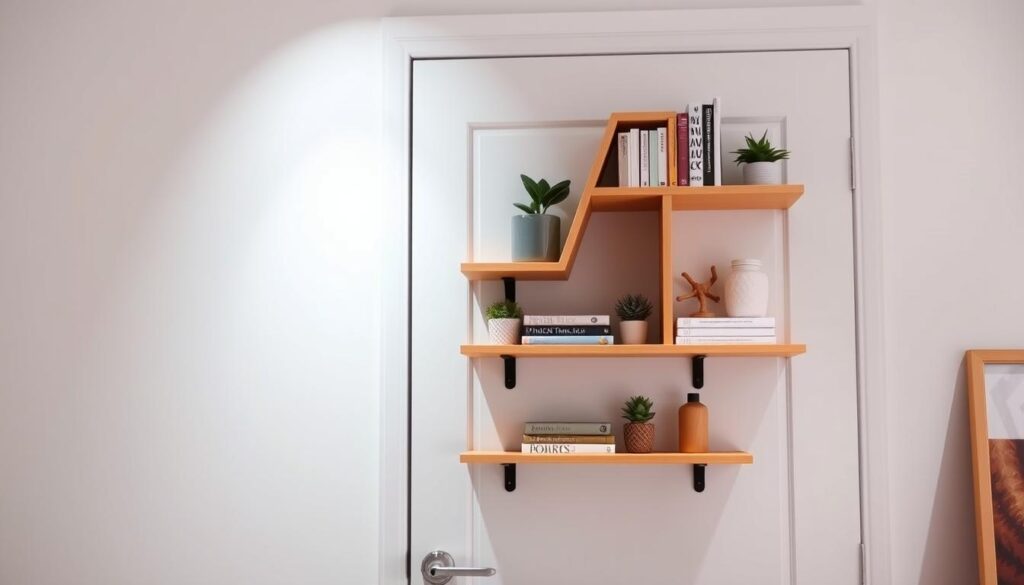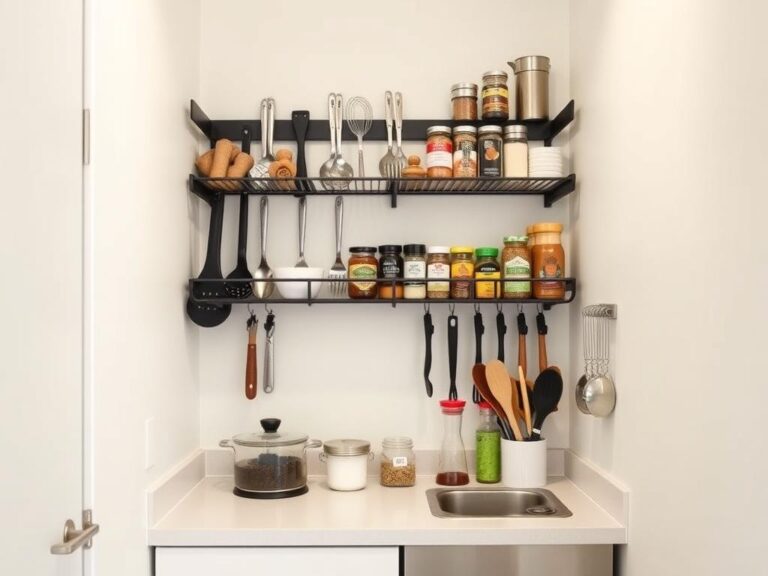8 genius ways to repurpose shoe organizers in your dorm
Discover 8 genius ways to repurpose shoe organizers in your dorm room. Maximize storage and stay organized with these creative ideas.
Dorm rooms are notorious for their cramped layouts. With limited square footage, students often struggle to keep belongings organized without sacrificing style. But what if you could turn a basic item into a multi-functional tool that maximizes every inch of your room?

Traditional storage accessories like hanging fabric units offer far more potential than their original purpose suggests. These lightweight, affordable tools can adapt to dorm life’s unique challenges—from keeping snacks within reach to corralling study supplies. We’ve curated eight unexpected methods to help you reimagine how to use them.
This guide focuses on practical, budget-friendly ideas that blend functionality with personal flair. Whether you’re storing tech gadgets or creating a mini pantry, these hacks prove that small spaces can still feel spacious. Ready to unlock your room’s hidden potential?
Key Takeaways
- Overcome tight layouts by using adaptable storage tools in new ways
- Create designated zones for snacks, school supplies, and accessories
- Save money with affordable upgrades that require no permanent changes
- Keep frequently used items easily accessible without clutter
- Combine practicality with decorative touches for a personalized space
Maximizing Dorm Storage with Repurpose Shoe Organizers
College living quarters demand smart solutions for tight layouts. Fabric storage units with multiple pockets offer surprising versatility beyond their original design. By rethinking where and how to hang them, you can double your usable area without drilling holes or buying bulky furniture.
Start by evaluating your room’s dead zones. The gap under your bed works perfectly for wheeled bins that slide out like drawers. These keep snacks or textbooks dust-free while freeing closets for bulkier items. Over-the-door styles thrive on closet rods or empty wall corners, creating instant shelves for daily essentials.
Three main designs adapt best to student needs:
What Else Would You Like to Know?
Choose below:
| Type | Best For | Space Saved | Cost Range |
|---|---|---|---|
| Hanging | Toiletries, school supplies | Vertical wall areas | $8-$15 |
| Over-the-Door | Shoes, cleaning supplies | Door backs | $12-$20 |
| Freestanding | Bedside items, snacks | Floor corners | $10-$18 |
Choose clear-pocket models for visibility or solid fabrics for a cleaner look. Pair them with adhesive hooks or tension rods to customize placements. This approach costs less than specialty dorm gear while offering equal – often better – functionality.
Students report saving 30% of their storage space using these methods. One sophomore notes: “I converted my door organizer into a charging station. Now my phone and laptop cords don’t disappear under my bed.”
Smart Storage Ideas for Small Spaces
Transforming cramped dorm rooms into functional spaces requires strategic thinking. Focus on zones often overlooked – like the 18-inch gap beneath beds or narrow wall strips beside desks. These areas become goldmines when paired with clever storage ideas that blend into daily routines.
Optimizing Every Inch in a Dorm
Measure vertical spaces first. Floor-to-ceiling solutions add capacity without shrinking walkways. Use these three approaches:
| Storage Zone | Best Use | Pro Tip |
|---|---|---|
| Under Bed | Seasonal clothes, bulk snacks | Use rolling bins for easy access |
| Behind Door | Cleaning supplies, towels | Install hooks at varying heights |
| Wall Corners | Books, chargers | Mount foldable shelves |
Creative Organizational Tactics
Multi-functional solutions work best in tight quarters. A fabric unit with pockets can hold school supplies while masking unsightly pipes. Label compartments to maintain order during hectic weeks.
Prioritize accessibility for frequently used items. Place snack caddies near study areas and gym gear close to the door. One student shared: “Color-coding my wall pockets cut my morning prep time in half.”
Remember – effective organization balances practicality with personal style. Choose neutral tones for versatility or bold patterns to energize your space.
Creative Dorm Arrangements Using Shoe Organizers
College life thrives on creativity, especially when space is at a premium. Fabric storage units with multiple compartments adapt beautifully to themed organization systems. Designate pockets for specific categories – like tech cords in one row and lip balms in another – to create intuitive daily routines.
- Beauty station: Sort makeup by type or color in clear pockets for quick access
- Study hub: Hang units near desks to store pens, sticky notes, and charging bricks
- Safety zone: Cooled hair tools slide neatly into deeper compartments
Pair units with existing furniture for seamless integration. Mount a 24-pocket design beside your closet to hold jewelry and hair accessories. Use adhesive hooks to secure the top edge, letting the bottom drape freely. One student shared: “Labeling each section helped me stop losing my AirPods case.”
Rotate items seasonally – swap beach towels for gloves in winter months. This flexibility keeps your system relevant without requiring new purchases. For visual harmony, choose organizers matching your bedding or wall art.
Innovative Uses for Over-the-Door Organization
Doors in dorm rooms often become overlooked storage goldmines. With proper design, these vertical surfaces can hold everything from textbooks to toiletries without cluttering floors. The key lies in balancing functionality with space-saving techniques tailored to student needs.

Design Tips for Hanging Organizers
Start by selecting hardware that protects your door’s finish. Adhesive hooks with rubber padding prevent scratches, while tension rods work for temporary setups. Distribute weight evenly by placing heavier items like bottles in lower pockets and lighter accessories higher up.
Avoid overloading compartments – most fabric units handle 2-3 pounds per pocket. For bulky items like sweaters, use reinforced models with double stitching. One student shared: “I hang my mini fridge supplies in door pockets. No more tripping over snack boxes!”
- Multi-room function: Stretch organizers between beds as room dividers
- Closet boost: Hang units inside closets for scarves or belts
- Quick fixes: Use binder clips to secure slipping hooks
Clean organizers monthly with damp cloths to prevent dust buildup. Rotate seasonal items every few months to maintain system efficiency. With these tips, your door becomes a dynamic storage hub that adapts to changing needs.
Under-bed and Wall-mounted Storage Solutions
Smart dorm layouts harness every available surface. Vertical spaces and under-bed zones offer hidden potential for storing essentials without shrinking your floor area. These methods work particularly well for seasonal items or supplies used less frequently.
Advantages of Vertical Organization
Wall-mounted systems free up valuable real estate in tight rooms. They keep items visible and accessible while preventing clutter buildup. Consider these three zones:
| Location | Best Items to Store | Weight Limit |
|---|---|---|
| Above Desk | Notebooks, chargers | 5 lbs |
| Bedside Wall | Books, water bottles | 8 lbs |
| Closet Adjacent | Belts, hats | 3 lbs |
One student notes: “Mounting my weekly planner and keys by the door stopped my morning scrambles.” Use adhesive strips rated for your wall type to avoid damage.
Practical Setup Tips
Measure your bed clearance before buying under-bed bins. Most dorms allow 6-8 inches of vertical space. Opt for wheeled containers that glide smoothly on carpet or tile.
- Label clear bins for quick identification
- Stack shallow containers vertically
- Use vacuum bags for bulky winter gear
For walls, start with lightweight materials like fabric grids. Gradually add heavier items as you confirm the mounting system’s stability. This approach maintains dorm compliance while maximizing your storage capacity.
Transforming Dorm Closets with Shoe Organizer Systems
Dorm closets often become chaotic catch-alls, but strategic organization can turn them into efficient storage hubs. Start by assessing your closet’s layout – measure shelves, hanging rods, and floor space. Vertical zones between existing features offer prime real estate for adding structure without renovations.
Install pocketed units along blank walls or beside hanging clothes. Assign compartments to specific categories: belts in top pockets, socks in middle rows, and seasonal items below. One student shared: “Labeling sections for workout gear and class supplies cut my morning search time by half.”
Combine different organizer styles for maximum impact:
- Hang clear-pocket designs on rods for visible accessory storage
- Use slim fabric grids on doors for jewelry or hair ties
- Anchor floor units with tension rods to prevent tipping
These systems adapt as needs change. During finals week, convert a shoe storage section into a snack station. Swap summer sandals for winter gloves without rearranging entire shelves. A sophomore noted: “My closet now holds three times more stuff, but everything stays findable.”
For narrow closets, layer organizers diagonally across corners. This creates accessible storage while maintaining room to reach hanging items. Choose neutral colors to blend with dorm walls or bold patterns for personality.
Incorporating LED Lighting for a Modern Look
Lighting transforms more than visibility—it reshapes how we interact with spaces. Adding LED strips to storage units creates a sleek aesthetic while solving practical dorm challenges. This upgrade turns basic setups into functional design statements that feel intentional and polished.
Start by selecting adhesive-backed LED strips with dorm-safe voltage. Measure your storage unit’s edges before cutting the lights to size. Peel the backing and press firmly along clean, dry surfaces. For fabric organizers, use clip-on puck lights instead to avoid adhesive damage.
Two primary systems work best for student needs:
| Type | Best For | Pros | Cons |
|---|---|---|---|
| Battery-Powered | Closets, temporary setups | No outlet needed | Regular battery changes |
| Plug-In | Desk areas, permanent use | Consistent brightness | Requires nearby outlet |
Position lights above compartments to illuminate contents without glare. One student noted: “My LED-lit cubbies make midnight snack grabs way easier.” Choose warm white tones for cozy vibes or color-changing options for weekend moods.
These systems do more than look cool—they prevent lost items and reduce eye strain during late-night study sessions. Always check dorm regulations before installing permanent fixtures. With strategic placement, your storage becomes both a practical tool and a modern design element that elevates your entire room.
Repurpose Shoe Organizers to Streamline Your Entryway
Your room’s entrance sets the tone for daily routines. Cluttered floors and misplaced keys disappear when you design intentional drop zones. Combine seating with smart storage to transform cramped entry areas into functional command centers.
Start by positioning a slim bench near the door. Choose models with open shelves or built-in cubbies underneath. These hold frequently worn footwear while providing a perch for tying laces. One student notes: “My bench’s lower shelf keeps rain boots contained, and the top holds my backpack during class swaps.”
Dual-Purpose Furniture Solutions
Maximize limited square footage with pieces serving multiple roles. A 36-inch bench with hidden compartments offers:
- Surface space for sorting mail or charging devices
- Vertical pockets along the sides for umbrellas or reusable bags
- Under-seat storage for seasonal accessories
Adhere to these guidelines for optimal flow:
| Zone | Essential Items | Access Time |
|---|---|---|
| Top Surface | Keys, transit cards | Instant grab |
| Middle Pockets | Hats, gloves | Under 5 seconds |
| Lower Storage | Bags, bulkier shoes | 10-15 seconds |
Maintain clear pathways by keeping daily essentials within arm’s reach. Use wall-mounted racks above benches for coats and scarves. This layered approach prevents tripping hazards while keeping your space guest-ready.
DIY Repurposing Projects and Custom Designs
Custom storage solutions gain new life when tailored to your unique needs. With basic tools and creativity, fabric caddies transform into personalized systems that solve specific dorm challenges. Start by sketching your ideal layout – whether adding extra pockets to existing furniture or creating modular units that adapt weekly.
Cutting and reshaping materials requires simple precautions. Always wear safety glasses when using scissors or craft knives. Reinforce seams with heavy-duty thread or fabric glue for long-lasting results. One student shares: “I turned a 24-pocket unit into a foldable craft station. Now my paints and brushes stay organized between classes.”
Try these beginner-friendly upgrades:
- Attach individual pockets to desk legs for quick-access school supplies
- Combine two vertical units with zip ties for a room divider with storage
- Dye fabric compartments to match your color scheme using fabric paint
| Materials | Purpose | Cost |
|---|---|---|
| Fabric organizers | Base structure | $8-$15 |
| Adhesive Velcro | Removable attachments | $4 |
| Acrylic paint | Custom colors | $3/bottle |
Labeling systems boost functionality while adding personality. Use iron-on patches for durable identification or chalkboard labels for adjustable categories. These custom designs grow with your needs – add pockets during finals week or remove sections for summer storage.
Remember to test weight limits before loading modified compartments. Start with lightweight items like stationery, gradually adding heavier objects as you confirm stability. With thoughtful planning, your creations will balance practicality with self-expression throughout the school year.
Dorm Room Organization Hacks with Shoe Caddies
Ordinary storage tools become extraordinary when paired with fresh thinking. Fabric caddies with multiple compartments adapt to dorm life’s unique demands, offering solutions for both productivity and hobbies. Let’s explore how to transform these versatile tools into functional systems that spark joy in tight spaces.
Turn Old Caddies into Supply Holders
Revitalize worn units by assigning them new roles. Use deep pockets to corral art supplies like paint tubes or sketchbooks. Clear sections keep items visible, while solid fabrics hide clutter during study sessions.
- Art station: Sort brushes by size in vertical rows
- Study hub: Store flashcards and highlighters near desks
- Craft corner: Keep glue guns and scissors in sturdy bottom pockets
Budget-Friendly Gardening Alternatives
Small-scale greenery thrives in dorm rooms with smart setups. Line pockets with waterproof liners before adding soil and seeds. Choose plants that tolerate low light and infrequent watering.
| Plant Type | Light Needs | Water Frequency |
|---|---|---|
| Herbs (mint, basil) | Medium | Every 3 days |
| Succulents | Low | Weekly |
| Pothos | Indirect | When dry |
One student shared: “My caddy herb garden lets me garnish ramen without leaving my room.” Rotate plants weekly for even sun exposure and trim roots monthly to prevent overcrowding.
Versatile Uses Beyond Footwear Storage
University spaces demand adaptable tools that evolve with student needs. Fabric pocket systems designed for one purpose often excel in completely different roles. Their grid-like structure and modular design make them ideal for storing unpredictable collections – from tangled cords to seasonal accessories.
Students nationwide have discovered surprising applications. One sophomore explains: “I use bottom pockets for snack bars and top rows for charging bricks. It’s like having a mini convenience store by my desk.” These solutions outperform single-use containers through three key advantages:
| Item Category | Storage Benefit | Setup Tip |
|---|---|---|
| Electronics | Prevents cord tangling | Label pockets by device type |
| Toiletries | Saves bathroom counter space | Use waterproof liner bags |
| Seasonal Gear | Easy rotation system | Store off-season items lower |
Clear compartments help visual learners maintain order. A music major shares: “My sheet music stays organized by genre in labeled sections. No more frantic searches before rehearsals.”
Compared to specialty dorm gear, these systems cost 60% less while offering similar functionality. Their lightweight construction allows quick reconfiguration during finals week or roommate changes. For crafters, deep pockets hold yarn skeins upright – a hack one student calls “a game-changer for small-space hobbies.”
Style Meets Function: Design Choices for Shoe Storage
Storage solutions can elevate room aesthetics while keeping essentials handy. Choose design elements that blend with your dorm’s vibe – transparent pockets suit modern spaces, while woven textures add rustic charm. Bold color choices like coral or sage green turn basic units into intentional decor pieces.
Match materials to your lifestyle. Waterproof fabrics withstand spills near desks, while breathable cotton works for closet storage. Neutral tones create calm in busy rooms, but vibrant hues make small spaces feel energetic.
Coordinate with existing furniture through pattern echoes or complementary shades. A geometric-print unit might mirror your bedding, creating visual harmony. Remember: function thrives when storage enhances your environment rather than competing with it.
For cohesive shoe storage systems, layer matching bins under beds with door-hung counterparts. This approach maintains style consistency while maximizing every corner. As one student notes: “My mint-green units make morning routines feel polished, even during finals week.”
FAQ
How can shoe organizers improve dorm storage?
What types of over-the-door organizers work best for small spaces?
Can these organizers handle heavy items like books?
How do I integrate LED lighting with hanging storage?
Are there budget-friendly alternatives for gardening in dorms?
What design tips make organizers blend with dorm decor?
Can under-bed storage work with vertical organizers?
How do I customize organizers without damaging dorm walls?
Tiny Kitchen, Big Ideas: Organizing Your Small Student Kitchen
» See exclusive tips for your home








